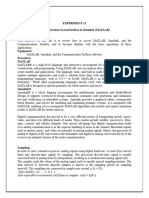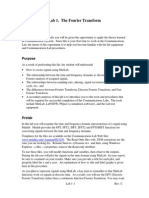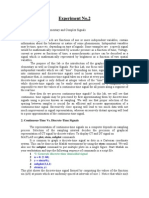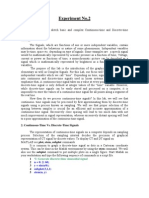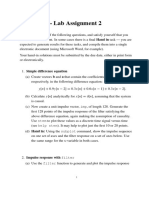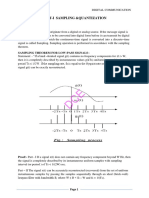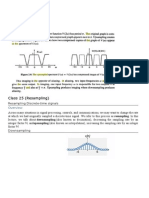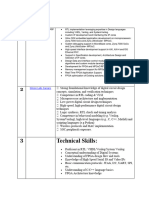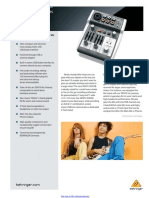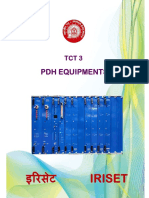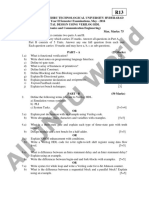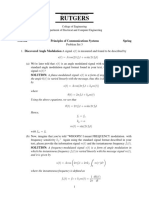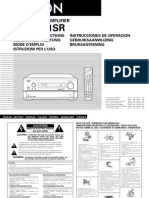EE370 Lab Experiment 07
EE370 Lab Experiment 07
Uploaded by
Mustaq AhmedCopyright:
Available Formats
EE370 Lab Experiment 07
EE370 Lab Experiment 07
Uploaded by
Mustaq AhmedCopyright
Available Formats
Share this document
Did you find this document useful?
Is this content inappropriate?
Copyright:
Available Formats
EE370 Lab Experiment 07
EE370 Lab Experiment 07
Uploaded by
Mustaq AhmedCopyright:
Available Formats
EE 370 - Communications Engineering I Lab
Experiment
Sampling & Quantization
MATLAB Simulation
Objectives
The main objectives of this experiment are:
1) To gain a clearer understanding of sampling theory and uniform quantization. 2) To learn how to simulate these operations using MATLAB.
Pre-Lab Work
Use the MATLAB function pulstran to generate and plot three periodic pulse trains with different shapes each with three different pulse durations. Read the help of that function and try to take advantage of the example given is at the end of the help for pulstran. However, do not copy it! Given a vector x=[1.1,2.6,-3.5,-0.001,0.768], apply the MATLAB functions fix, round, floor, & ceil on x. State the differences between the resulting vectors.
Overview
An analog signal is characterized by the fact that its attributes (like: amplitude, frequency and phase) can take any value over a continuous range. On the other hand, digital signals can take only discrete and finite values. One can convert an analog signal to a digital signal by sampling and quantizing (collectively called analog-to-digital conversion, or ADC). It is typically more efficient to process the resulting discrete signals by digital signal processors,. The processed signals are then converted back into analog signals using a reconstruction or interpolation operation (called digital-to-analog conversion, or DAC).
Sampling:
To sample a continuous-time signal x(t ) is to represent x(t ) at a discrete number of points,
t = nTs , where Ts is the sampling period. The sampling theorem states that a band-limited signal x(t ) with a bandwidth W can be reconstructed from its sample values x (n) = x( nTs ) if
29
Copyright Electrical Engineering Department, KFUPM.
EE 370 - Communications Engineering I Lab
the sampling frequency f s = 1 / Ts is greater than twice the bandwidth W of aliasing would result in signal is called the Nyquist rate.
x(t ) . Otherwise,
x(t ) . The minimum sampling rate of 2 f s for an analog band-limited
Quantization :
In order to process the sampled signal digitally, the sample values have to be quantized to a finite number of levels, and each value can then be represented by a string of bits. For example, if the signal is quantized to N different levels, then log2(N) bits per sample are required. Notice that to quantize a sample value is to round it to the nearest point among a finite set of permissible values. Therefore, a distortion will inevitably occur. This is called quantization noise (or error). Quantization can be classified as uniform and non-uniform. In the case of uniform quantization, the quantization regions are chosen to have equal length. However, in non-uniform quantization, regions of various lengths are allowed. Non-uniform quantization can be implemented through compression-expansion (or companding) of the signal, and this is commonly used (as in telephony) to maintain a uniform signal-to-quantization noise ratio over the full dynamic range of the signal (refer to your textbook for more details).
Lab Work
1)
Generate a time vector t from -0.5 to 0.5 with a step size of 0.001. Implement the function x (t ) = e the following tasks:
|t |/
where = 0.1 . In order to simulate an A/D converter, perform
a. Plot x and its magnitude spectrum in a two-panel figure window. What is the bandwidth of x? b. Set the sampling frequency to twice the bandwidth of the signal x (which is approximately 25Hz). Generate a rectangular pulse train starting at -2 to 2 where the step size is 1/(sampling frequency) and with a duration 1E-10. In a two-panel figure window, plot the pulse train and its magnitude spectrum. What is the relation between the time and frequency domain representation of the pulse train? c. Sample x using the pulse train and plot the resulting sampled version of x, (say xs). Also, plot its magnitude spectrum. What can you observe from both plots?
Now, to be able to simulate a D/A converter, perform the following tasks: d. Let h be a vector of forty ones (40). Plot its magnitude spectrum. In order to correctly plot H(f), use the fft function with a number of FFT points equal to the length of x.
30
Copyright Electrical Engineering Department, KFUPM.
EE 370 - Communications Engineering I Lab
e. Use the function filter to form the reconstructed signal (say xd) from xs using the filter h, i.e, xd=filter(h,1,xs). In a 4-panel figure window, show the plots of x, xd, and there magnitude spectrums. Comment on your findings. Useful MATLAB functions: pulstran
2) 3) 4)
Repeat 1 using a sampling frequency equal to 1.5 times the bandwidth of x(t ) . Repeat 1 using a sampling frequency equal to 10 times the bandwidth of
x(t ) .
Generate a sine signal (call it x) with frequency equal to 1 / 2 over a time interval of three periods. The step size should be equal to 1E-4. The quantized signal will be equal to xq = x round ( x / ) , where is the quantization step size. You can compute it using the formula = 2 max(| x |) / L where L = 2 and b is the number of quantization bits. Use 2 bits to quantize x and show the following:
b
a. In one figure plot x vs. time and the quantized signal vs. time. b. Compute the Signal-to-Quantization Noise Ratio (SQNR) defined by the formula: SQNR = 10 log10 (
5) 6)
x (x x
2
) 2 ) in dB.
Repeat Part 4 using 3, 4 and 5 bits per sample. Plot the SQNR vs. the number of bits per sample for 2, 3, 4, and 5 bits. What is your conclusion?
Additional Questions:
Q1. Can you process real-world analog signal by digital computers? List possible applications where sampling and quantization are necessary. Q2. From the above results, what can you conclude about the improvement in SQNR with every additional quantization bit?
31
Copyright Electrical Engineering Department, KFUPM.
You might also like
- Sin (X) X Agilent PDFDocument10 pagesSin (X) X Agilent PDFm1dasNo ratings yet
- Digital Spectral Analysis MATLAB® Software User GuideFrom EverandDigital Spectral Analysis MATLAB® Software User GuideNo ratings yet
- PCB Design WorkshopDocument18 pagesPCB Design WorkshopPrasun SinhaNo ratings yet
- Line Follower Robot PresentationDocument25 pagesLine Follower Robot Presentationmirrayhan0867% (6)
- Lab 13 05012023 022249pm 1Document5 pagesLab 13 05012023 022249pm 1nihib66608No ratings yet
- LAB 4: Sampling ObjectivesDocument17 pagesLAB 4: Sampling Objectivesmjrahimi.eee2020No ratings yet
- Fourier LabDocument6 pagesFourier LabAzeem IqbalNo ratings yet
- LAB MANUAL of DSP-3105Document12 pagesLAB MANUAL of DSP-3105Eayashen ArafatNo ratings yet
- Lab 1 - DT Signals, Sampling, Frequency Entry Test Example QuestionsDocument2 pagesLab 1 - DT Signals, Sampling, Frequency Entry Test Example QuestionsAndrea FieldsNo ratings yet
- Matlab Ss SolnDocument7 pagesMatlab Ss Solncheenu15No ratings yet
- Project2 2010Document4 pagesProject2 2010Omar NasrNo ratings yet
- Solutions Manual For Digital Communications in PracticeDocument48 pagesSolutions Manual For Digital Communications in PracticecasdeaNo ratings yet
- Experiment No:1: Aim:Write A Program For Sampling. Software Used:matlab TheoryDocument44 pagesExperiment No:1: Aim:Write A Program For Sampling. Software Used:matlab Theoryauro auroNo ratings yet
- Lab 1. The Fourier Transform: WWW - Utdallas.edu/ kamran/EE4250Document10 pagesLab 1. The Fourier Transform: WWW - Utdallas.edu/ kamran/EE4250sklansNo ratings yet
- digital 2Document21 pagesdigital 2a7madsala7ussainNo ratings yet
- Experiment 3Document4 pagesExperiment 3Lovely Eulin FulgarNo ratings yet
- Lab 9 Exercise - Sampling Theorem - 2024Document4 pagesLab 9 Exercise - Sampling Theorem - 2024jaberhajer68No ratings yet
- 24.378 Signal Processing I Laboratory 2: U (T-A), HDocument2 pages24.378 Signal Processing I Laboratory 2: U (T-A), HRodrigoNo ratings yet
- Lab ManualsDocument22 pagesLab ManualsHailRodNo ratings yet
- Experiment No.2: Aim: Introduction of Elementary and Complex Signals. TheoryDocument4 pagesExperiment No.2: Aim: Introduction of Elementary and Complex Signals. TheorySaloni Agarwal100% (1)
- Lab Report Exp 1Document20 pagesLab Report Exp 1Elisbeth MurugasNo ratings yet
- ELEC6021 Communications Assignment I: Submission DetailsDocument15 pagesELEC6021 Communications Assignment I: Submission DetailsAnonymous DGq0O15nNzNo ratings yet
- Ee4015 Matlab3Document4 pagesEe4015 Matlab3Abdul RahimNo ratings yet
- Lab Sheet 3: Sampling Reconstruction and Quantization of DT SignalsDocument15 pagesLab Sheet 3: Sampling Reconstruction and Quantization of DT SignalsSharmin RiniNo ratings yet
- Experiment No. 2Document4 pagesExperiment No. 2Sandeep KumarNo ratings yet
- DSP Lab ExptList 2020Document10 pagesDSP Lab ExptList 2020deepak raja.sekar.p.mNo ratings yet
- Digital Signal Processing - Exercises: 1 Sequences and SystemsDocument7 pagesDigital Signal Processing - Exercises: 1 Sequences and SystemsAsia YasirNo ratings yet
- DSP Lab 2RTDocument5 pagesDSP Lab 2RTMatlali SeutloaliNo ratings yet
- Data Comm EXP 5 Student ManualDocument5 pagesData Comm EXP 5 Student Manualdark lionNo ratings yet
- Dcom Manual Lab 07Document5 pagesDcom Manual Lab 07Faiza MushtaqNo ratings yet
- Exp1 PDFDocument12 pagesExp1 PDFanon_435139760No ratings yet
- Problem Set 1Document4 pagesProblem Set 1Rushabh Mehta100% (1)
- The Hong Kong Polytechnic University Department of Electronic and Information EngineeringDocument4 pagesThe Hong Kong Polytechnic University Department of Electronic and Information EngineeringNiaz ManikNo ratings yet
- Principles Comm EXP 3 Student ManualDocument5 pagesPrinciples Comm EXP 3 Student Manualxyzmd2000No ratings yet
- Unit-I Sampling &quantization Sampling:: Sampling Theorem For Low-Pass SignalsDocument20 pagesUnit-I Sampling &quantization Sampling:: Sampling Theorem For Low-Pass SignalsRajasekar PichaimuthuNo ratings yet
- Effects of Sampling and Aliasing in Discrete Time SinusoidsDocument7 pagesEffects of Sampling and Aliasing in Discrete Time SinusoidsJuman RehmanNo ratings yet
- Dr. Manzuri Computer Assignment 1: Sharif University of Technology Computer Engineering DepartmentDocument3 pagesDr. Manzuri Computer Assignment 1: Sharif University of Technology Computer Engineering DepartmentsaharNo ratings yet
- Project 1 Matched Filters: Applications of Cross-CorrelationDocument4 pagesProject 1 Matched Filters: Applications of Cross-CorrelationDavidRubeomNo ratings yet
- ELEC6021 Comms Assignment 1Document15 pagesELEC6021 Comms Assignment 1mohamed walidNo ratings yet
- Aliasing Using MATLAB-An IllustrationDocument6 pagesAliasing Using MATLAB-An IllustrationGaurav SharmaNo ratings yet
- 1043Document6 pages1043Eng-Sa'di Y. TamimiNo ratings yet
- Mobile Communications: Homework 03Document4 pagesMobile Communications: Homework 03Shahzeeb PkNo ratings yet
- OFDMDocument5 pagesOFDMUsama JavedNo ratings yet
- DsssssssssDocument41 pagesDsssssssssBaymax TadashiNo ratings yet
- EEE - 321: Signals and Systems Lab Assignment 1Document7 pagesEEE - 321: Signals and Systems Lab Assignment 1Atakan YiğitNo ratings yet
- DSP Lab 7 ManualDocument10 pagesDSP Lab 7 ManualAR Rehman0% (1)
- Sampling With Automatic Gain Control 4Document31 pagesSampling With Automatic Gain Control 4anandbabugopathotiNo ratings yet
- The Hong Kong Polytechnic University Department of Electronic and Information EngineeringDocument6 pagesThe Hong Kong Polytechnic University Department of Electronic and Information EngineeringSandeep YadavNo ratings yet
- Frequency Response Ex-4Document6 pagesFrequency Response Ex-4John Anthony JoseNo ratings yet
- Experiments1 5Document15 pagesExperiments1 5Sameer ShaikhNo ratings yet
- Data Communication EXP 3 Student ManualDocument5 pagesData Communication EXP 3 Student ManualMohammad Saydul AlamNo ratings yet
- LAB4_MTIDocument2 pagesLAB4_MTIhassinehanane123No ratings yet
- EE115IU_Lab4Document5 pagesEE115IU_Lab4vinhhoang140403glNo ratings yet
- Analog To Digital Conversion: KIE2008 (Week 4-5)Document42 pagesAnalog To Digital Conversion: KIE2008 (Week 4-5)Kisshur KumarNo ratings yet
- OctaveDocument122 pagesOctaveTarik ZiadNo ratings yet
- Digital Signal Processing NotesDocument18 pagesDigital Signal Processing NotesDanial ZamanNo ratings yet
- Behavioral Modeling of Time-Interleaved ADCs UsingDocument4 pagesBehavioral Modeling of Time-Interleaved ADCs Usingrezam56No ratings yet
- DSP Lab ReportDocument22 pagesDSP Lab ReportMd AshikNo ratings yet
- Null 2Document8 pagesNull 2ahmedabdulkarim554No ratings yet
- Spline and Spline Wavelet Methods with Applications to Signal and Image Processing: Volume III: Selected TopicsFrom EverandSpline and Spline Wavelet Methods with Applications to Signal and Image Processing: Volume III: Selected TopicsNo ratings yet
- Fundamentals of Electronics 3: Discrete-time Signals and Systems, and Quantized Level SystemsFrom EverandFundamentals of Electronics 3: Discrete-time Signals and Systems, and Quantized Level SystemsNo ratings yet
- Measurements-Based Radar Signature Modeling: An Analysis FrameworkFrom EverandMeasurements-Based Radar Signature Modeling: An Analysis FrameworkNo ratings yet
- Idealtech PricelistDocument4 pagesIdealtech PricelistjadechooNo ratings yet
- S2.4_Digital_Wireless_Microphone_RX2_Manual-enDocument5 pagesS2.4_Digital_Wireless_Microphone_RX2_Manual-enEmbarkingZeusNo ratings yet
- Agilent E7495B Base Station Test Set Data SheetDocument16 pagesAgilent E7495B Base Station Test Set Data SheetJamilAwanNo ratings yet
- User's Manual - Gun Type Handheld CCD - Laser ScannerDocument92 pagesUser's Manual - Gun Type Handheld CCD - Laser ScannerJohnOaksNo ratings yet
- Acterna ANT 5 SDH Test Set Data SheetDocument8 pagesActerna ANT 5 SDH Test Set Data SheethoangplNo ratings yet
- Power Devices Part 2Document42 pagesPower Devices Part 2Anonymous rIBUACyoNo ratings yet
- Philips FWC143 (12,05)Document23 pagesPhilips FWC143 (12,05)boroda2410No ratings yet
- Sample Design Verification EngineerDocument7 pagesSample Design Verification Engineervishnu microarkNo ratings yet
- Behringer Xenyx 302 UsbDocument3 pagesBehringer Xenyx 302 UsbLuiz Henrique MendesNo ratings yet
- Textbook of Applied ElectronicsDocument8 pagesTextbook of Applied Electronicsshehnasheh99No ratings yet
- TCT3hl 3Document144 pagesTCT3hl 3ashish118No ratings yet
- JNTUH 2-2 ECE May 2016Document13 pagesJNTUH 2-2 ECE May 2016mushahedNo ratings yet
- Pv507ba UnikcDocument8 pagesPv507ba UnikcDoddy PrasetyaNo ratings yet
- Servelec Technologies - Kingfisher PLUS RTUs - PC-1 End of Production Notice PDFDocument5 pagesServelec Technologies - Kingfisher PLUS RTUs - PC-1 End of Production Notice PDFjishyNo ratings yet
- C-Zone SDN BHD: RM 909 RM 819Document2 pagesC-Zone SDN BHD: RM 909 RM 819Aiman AmirNo ratings yet
- 002-08513 MB3773 Power Supply Monitor With Watch Dog TimerDocument28 pages002-08513 MB3773 Power Supply Monitor With Watch Dog TimerAhmad Yuli SaputroNo ratings yet
- pcshw3 SolnDocument6 pagespcshw3 SolnBhuvaneshwari BNo ratings yet
- tcp54vt25 PDFDocument144 pagestcp54vt25 PDFJay HunterNo ratings yet
- Communications Question BankDocument15 pagesCommunications Question BankiamjaeboomNo ratings yet
- Denon AVC A11SRDocument43 pagesDenon AVC A11SRKees de KoningNo ratings yet
- KA317Document6 pagesKA317Blanca MartinezNo ratings yet
- Invertek Drives ODE-3-220105-1042-01 DatasheetDocument2 pagesInvertek Drives ODE-3-220105-1042-01 DatasheetMichael Castaño MoralesNo ratings yet
- MPX5010Document16 pagesMPX5010Arsonval FleuryNo ratings yet
- York Max-E Model YRDocument168 pagesYork Max-E Model YRmarco_christoforidis100% (6)
- 74HC164 74HCT164: 1. General DescriptionDocument17 pages74HC164 74HCT164: 1. General DescriptionTDFRIOGRANDENo ratings yet
- Analog Audio Amplifier DesignDocument36 pagesAnalog Audio Amplifier DesignNest YeenNo ratings yet
- Psebm150 ADocument45 pagesPsebm150 AMohamedElsawiNo ratings yet
- PM500 DatasheetDocument8 pagesPM500 Datasheetmehrdad95.hNo ratings yet




